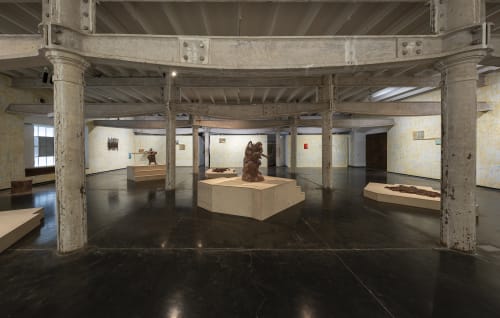Project 88 is pleased to present A Forest of Remembrance, Amol K Patil’s second solo exhibition at our gallery space in Mumbai. Patil’s works infuse a radical imaginary of resistance into corporeal encounters, distilling the layered complexities (and erasures) implicit in the making of an urban metropolis.In these works, Patil returns to the relation between transience and permanence in Mumbai’s chawls, thinking through the precarious conditions of migrant labourers. This exhibition is a site-specific excerpt of Patil’s larger project — with the same title — exhibited earlier this year at the Berkeley Art Museum and Pacific Film Archive (BAMPFA), California, marking the artist’s first institutional solo in the US, curated by Victoria Sung, Margot Norton, and Tausif Noor.
A Forest of Remembrance comprises a new body of works by the artist, with large-scale sculptures and small paintings seen across fluctuating daylight, marking a departure from Patil’s previous exhibition at our space, Black Masks in Roller Skates, where each work was shrouded in the dark with shadows emerging from dim, eerie light bulbs.
In a curatorial text written by Tausif Noor for the show at BAMPFA, he writes:
“A tangle of USB cords and mobile phone chargers are nestled into a fluorescent pink basket beside photographs of family members; plastic and tin food containers sit stacked high on shelves; worn electrical outlets and wires climb up stucco walls, yellowed with age. With careful, illusionistic brushstrokes, Amol K. Patil (b. 1987, Mumbai) lovingly renders the stuff and spaces of India’s striving urban lower and middle-class inhabitants, scaling their ambitions, hopes, and dreams onto small canvases. Steeped in the socially conscious artistic traditions of the Dalit movement, Patil’s multidisciplinary practice—spanning performance, video, painting, and sculpture—reflects the diversity of artistic forms to which he was exposed as a member of the Dalit community.
Originating from the soil of his native Mumbai and then cast in bronze, these sculptures materialize Patil’s interest in speaking to the collective. We can make out faces, but we cannot attribute particular visages to individual bodies. Limbs poke out from the lumpy centers of these bronze forms: each hand seems to grip another in a frenzy of activity, each pair of feet implying that these static structures might soon be on the move. We are forced to reckon with multiple forms of entanglement: between bodies locked in step with one another, between individuals and their environment, between the oppressed and their histories of resistance ...Patil gives each limb, each figure, each sundry object and trinket in an ordinary household a solidity and weight, urging us to recognize the same importance and strength in one another. This is the promise of Patil’s work—a promise that our struggles are interconnected, no matter what space we occupy in life.”


